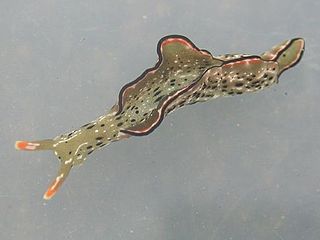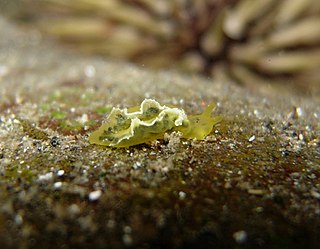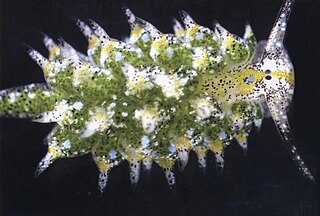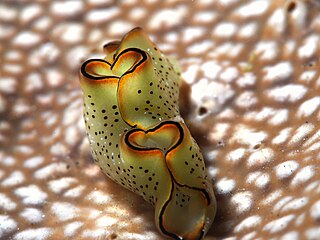
Sacoglossa are a superorder of small sea slugs and sea snails, marine gastropod mollusks that belong to the clade Heterobranchia known as sacoglossans. There are 284 valid species recognized within this superorder. Sacoglossans live by ingesting the cellular contents of algae, hence they are sometimes called "sap-sucking sea slugs". Some sacoglossans simply digest the fluid which they suck from the algae, but in some other species, the slugs sequester and use within their own tissues living chloroplasts from the algae they eat, a very unusual phenomenon known as kleptoplasty, for the "stolen" plastids. This earns them the title of the "solar-powered sea slugs", and makes them unique among metazoan organisms, for otherwise kleptoplasty is known only among single-celled protists.

Elysia subornata is a species of small sea slug, a marine opisthobranch gastropod mollusk in the family Plakobranchidae.

Elysia is a genus of sea slugs, marine gastropod molluscs in the family Plakobranchidae. These animals are colorful sea slugs, and they can superficially resemble nudibranchs, but are not very closely related to them. Instead they are sacoglossans, commonly known as sap-sucking slugs.

Elysia crispata, common name the lettuce sea slug or lettuce slug, is a large and colorful species of sea slug, a marine gastropod mollusk.

Elysia ornata, commonly known as ornate elysia or ornate leaf slug, is a species of sea slug, a marine gastropod mollusk. This sea slug superficially resembles a nudibranch, yet it does not belong to that suborder of gastropods. Instead it is a member of the closely related clade Sacoglossa, the "sap-sucking" sea slugs.

Elysia timida is a species of sacoglossan sea slug, a marine opisthobranch gastropod mollusk. Found in the Mediterranean and nearby parts of the Atlantic, it is herbivorous, feeding on various algae in shallow water.

Elysia pusilla is a species of small sea slug, a marine gastropod mollusk in the family Plakobranchidae. It is a sacoglossan.

Plakobranchus ocellatus is a species of sea slug, a sacoglossan, a marine opisthobranch gastropod mollusk in the family Plakobranchidae. It is found in shallow water in the Indo-Pacific region.

Bosellia mimetica is a species of sea slug, a marine gastropod mollusk in the family Plakobranchidae. It is a very small sea slug growing to less than 1 centimetre (0.4 in) in length. It has a rounded, flattened body and is a mottled green, a colour that mimics that of the algae Halimeda tuna and Flabellia petiolata on which it lives and feeds. Its range includes the Mediterranean Sea, the Iberian peninsula, the Caribbean Sea and the Atlantic coast of South America. The type locality is the island of Capri, in Italy.
Felimare agassizii is a species of sea slug or dorid nudibranch, a marine gastropod mollusk in the family Chromodorididae.

Elysia catulus is a small species of sea slug, a marine gastropod mollusc in the family Plakobranchidae. This sea slug resembles a nudibranch, but it is not closely related to that order of gastropods, instead it is a sacoglossan. The specific name "catulus" comes from the Greek and means "little cat", referring to the superficial resemblance that the head of this slug bears to the head of a cat.

Elysia margaritae is a species of sea slug, a marine gastropod mollusc.

Elysia australis is a species of sea slug, a marine gastropod mollusc in the family Plakobranchidae. This sea slug resembles a nudibranch, but it is not closely related to that order of gastropods, instead it is a sacoglossan. It occurs in Australia.

Elysia obtusa is a species of sea slug, a marine gastropod mollusc in the family Plakobranchidae. This sea slug resembles a nudibranch but is not closely related to that order of gastropods, instead it is a sacoglossan.

Elysia trisinuata is a species of sea slug, a marine gastropod mollusc in the family Plakobranchidae. This sea slug resembles a nudibranch but is not closely related to that order of gastropods, instead belonging to another clade, Sacoglossa, the "sap-sucking" sea slugs.
Elysia rufescens is a species of sea slug, a marine gastropod mollusc in the family Plakobranchidae. This sea slug resembles a nudibranch but is not classified in that order of gastropods, instead belonging to a closely related clade, Sacoglossa, the "sap-sucking" sea slugs. This species was first described by Pease from Tahiti in 1871.
Elysia serca, the seagrass elysia or Caribbean seagrass elysia, is a species of sea slug, a marine gastropod mollusc in the family Plakobranchidae. Although this sea slug resembles a nudibranch, it is not a nudibranch; it belongs to the clade, Sacoglossa, the "sap-sucking" sea slugs. It was first described by Marcus in 1955 from specimens found in Brazil.

Elysia bangtawaensis is a species of sea slug, a marine gastropod mollusc in the family Plakobranchidae. Although this sea slug resembles a nudibranch, it is not a nudibranch but is part of a rather different clade, the sacoglossans, also known as the "sap-sucking" sea slugs.

Costasiella ocellifera is a small (5–13 mm) species of sea slug, a shell-less marine gastropod mollusk in the family Costasiellidae. Costasiella ocellifera, and other members of the Costasiellidae family are often mistakenly classified as nudibranchs because they superficially resemble other species of that group, but they are actually a part of the Sacoglossa superorder of sea slugs, also known as the “sap-sucking sea slugs,” "crawling leaves" or the "solar-powered sea slugs." C. ocellifera was discovered by Simroth in 1895, and was initially classified as Doto ocellifera. The Brazilian species, Costasiella liliana, is a synonym of C. ocellifera.Costasiella ocellifera shows long-term retention of functional kleptoplasty.

Elysia marginata is a marine gastropod in the family Plakobranchidae. It is known for its ability to regenerate its whole body and heart after autotomizing it from its head.

















